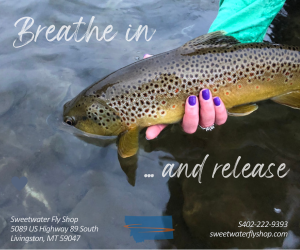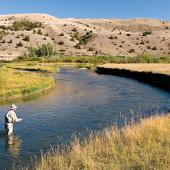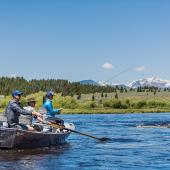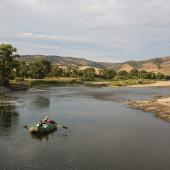The Right Stuff
The fly-fishing essentials.
Given the variety of water bodies in southwest Montana, along with the area’s reputation as a fishing paradise, anglers can often be led to believe that they need a dozen different rods and a whole myriad of other equipment to catch fish. However, whether drifting the banks of a big river or casting tiny dry flies to rising trout on a spring creek, there are only a few pieces of essential gear that anglers really need to stay on top of fish in all situations.
Rods & Reels
Although many anglers own entire golf bag of fly rods, the truth is they only need one or two. Most of the water, from the mighty Madison and Yellowstone to the smallest mountain streams, can be fished with a nine-foot, five-weight. This rod is perfect for fishing both nymphs and dry flies, and the stiff flex of a fast-action rod will help when fishing in strong winds, or when casting heavy nymph rigs or streamers. Other rods that can be good to bring along include a mid-flex seven-weight for fishing extremely large streamers, and a full-flex three-weight for targeting smaller fish in smaller water.
Unless an angler is strictly sticking to fishing small creeks and small fish, it’s best to use a reel with both a large arbor and a disc drag system. The open design of such reels makes tangles easy to sort out, and leaves lots of room for backing. Combined with a disc drag, these modern reels are perfect for fighting large trout in strong currents, preventing anglers from having to sprint downstream should they hook into a monster.
With a few basic pieces of gear in mind, even the most minimally-equipped angler can be prepared for whatever situation he finds himself in while fishing the hallowed waters of southwest Montana.
Lines & Leaders
When it comes to lines, a basic weight-forward floating line will cover most situations. This line is excellent for dry-fly fishing, nymphing, or even streamer fishing when combined with a sinking leader.
Leaders should be nine feet long, and between 3X and 5X in diameter. This range of sizes will handle most fishing situations, but can be easily trimmed down or lengthened when necessary. Anglers should carry a variety of tippet, ranging from 4X to 6X, which can be added to the leader when fishing in deeper water or when casting to finicky trout in clear water.
Waders & Other Gear
Wet wading is, of course, always an option when fishing in the summer. However, should you be fishing in colder weather, it’s a good idea to bring a pair of waders along. Boot-foot waders are a great and inexpensive option, and will work just fine in most situations. However, for fishing a variety of terrain, stocking-foot waders with a separate pair of boots is usually a better option. These boots can also be used in conjunction with a pair of neoprene socks for wet wading in comfort. Such a setup is a favorite amongst anglers hiking into the wilderness in search of secret fishing holes, as the water gets extremely cold up in the high alpine, but a full set of waders is neither necessary nor practical.
Aside from waders and boots, anglers will want to bring a variety of both wet and dry flies, as well as split shot, strike indicators, and floatant. A fishing bag is also helpful to keep everything organized, but is far from essential. For the minimalist, pants and shirt pockets work just fine.
With these basic pieces of gear in mind, even the most minimally-equipped angler can be prepared for whatever situation he finds himself in while fishing the hallowed waters of southwest Montana.










